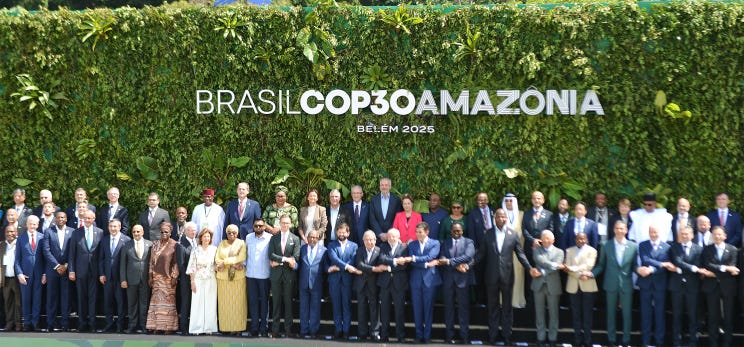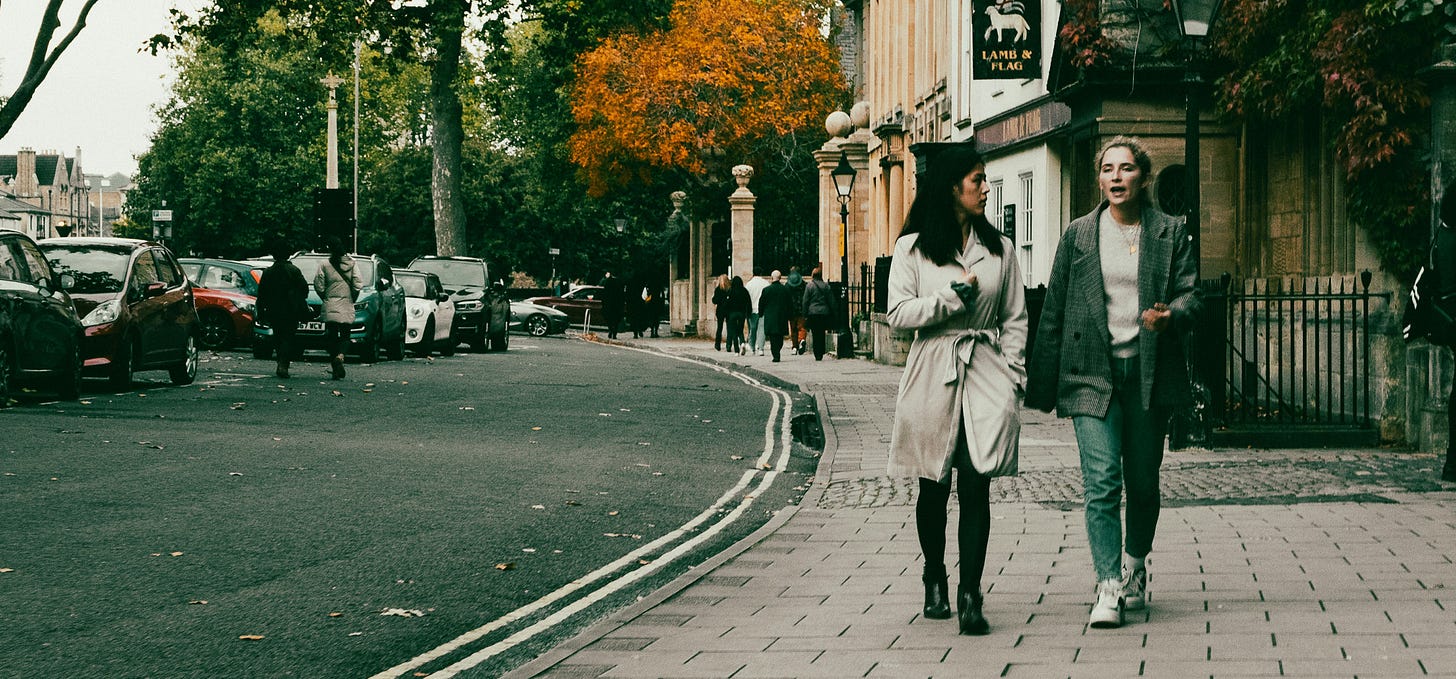What COP30 got right... and what it didn't
Global potluck makes progress but leaders dodge hard choices
International climate meeting number thirty wrapped up in Belém, Brazil last Saturday, marking the end of two weeks of negotiations, protests, and discussions. I didn’t attend COP30 myself, nor did many other scientists; yet there still weren’t enough hotel rooms for everyone who had to be there. Many attendees slept on cruise ships in rooms I heard were going for well over a thousand dollars a night ... while in the meantime an amazing initiative called “Hospitality with Purpose” mobilized local congregations to offer accommodations at fair prices and even some free rooms. I heard from journalist Phelipe Reis that their team of almost 50 people were put up in a church, while attendees from the Christian Climate Observers Program (a group I often meet with whenever I attend COP meetings) stayed on a boat belonging to the Brazilian Bible Society!
Last Thursday, a fire broke out inside the convention hall, prompting an evacuation of the blue zone and pausing delegates’ negotiations. Thankfully, the fire was brought under control quickly and no one was seriously injured. However, fellow climate scientist Michael Mann said the quiet part out loud when he dubbed this blaze “a disturbingly apt metaphor.” And this wasn’t the only symbolism these past two weeks: the conference venue was plagued with leaks from heavy downpours and an air conditioning system that couldn’t keep pace with the heat and humidity in Belém -- conditions that will become even more frequent as the planet warms.
This year marked a decade since the signing of the Paris Agreement and, despite the frustratingly slow pace of the COP meetings, significant progress has been made. As I shared two weeks ago, global emissions used to be tracking a scenario where warming would reach 4-5C (7-9F) by the end of the century. But thanks to all the policies enacted and advances in clean energy over the last decade, we’re currently heading towards a world that’s 2.8C (5F) warmer. And if all of the countries’ Nationally Determined Contributions are implemented, the warming will be around 2.4C (4.3F). For more on where things stand post Paris, see these ten graphs.
So, what happened at this COP? As always, there’s good news and not so good news.
COP meetings typically act like global potlucks, where–in addition to negotiating global agreements–each country brings its own unique contributions to the table.
In the host country of Brazil, for example, cattle ranching drives much of the illegal deforestation. So it was a major step forward when the governor of the state of Pará, where Belém is located, committed to tagging all 20 million cattle in the region to track deforestation. This is a huge project that The Nature Conservancy has championed for years: creating a digital paper trail to ensure no deforestation is linked to beef production.
The launch of the Tropical Forest Forever (TFF) fund brought more good news for nature. Backed by $5.5 billion in initial commitments, it aims to curb deforestation by rewarding countries that keep their forests intact. The Guardian’s Jonathan Watts called it “the biggest and boldest plan yet to staunch the loss of tropical forests that are a pillar of climate stability.” Brazil and Germany each have pledged $1 billion, with Norway promising $3 billion.
Other countries’ potluck contribution focused on clean energy. For example, South Korea operates the world’s seventh-largest fleet of coal plants. At COP30, it committed to closing all 40 plants by 2040 and build no new unabated plants. This makes South Korea the second Asian nation, after Singapore, to join the Powering Past Coal Alliance, launched in 2017 at COP23 in Germany.
Finally and most importantly, Colombia and the Netherlands announced the first International Conference on the Just Transition Away from Fossil Fuels, to be held in Colombia in April 2026. “There is a clear momentum to phase out fossil fuels, and now is the time to capitalize on it,” said Sophie Hermans, the Dutch Minister for Climate Policy and Green Growth. “We must begin to materialize what this phase-out could look like and start a concrete roadmap that allows us to incorporate the new and leave the old behind.”
Step by step, these commitments show that progress is possible—and that every action to move beyond fossil fuels brings us closer to ensuring a livable future.
This COP promised to be the “implementation COP” where countries would figure out how to limit temperature rise to the Paris target of 1-2C. So, did it deliver on that promise? In short, no.
Much of the last-minute negotiations hinged upon whether the final agreement included a pledge to “transition away from fossil fuels.” 83 countries, including the host country Brazil, pushed to have this statement included in the final agreement. They were supported by a letter organized by the We Mean Business coalition signed by over 150 other non-profits, regional and city governments, and companies, and strongly opposed by a coalition of oil-producing states led by Saudi Arabia and Russia.
COP agreements require consensus. As this helpful Carbon Brief article explains, this is a relic of the fact that countries never agreed on a decision-making process for COP when the UN Framework Convention on Climate Change was signed back in 1992. So the disagreement forced the negotiations into an overnight session on Friday, and on Saturday the final plenary session had to be suspended after negotiators from multiple countries, led by Colombia, claimed that the agreement was being gaveled through without letting them speak.
Ultimately, however, that wording didn’t make it into the final deal. Instead, the COP30 president promised that “the issue of stronger language on moving away from fossil fuels can be raised again in six months’ time at an interim COP meeting.” Here’s why this matters so much: because there is no path to meeting the Paris targets without almost entirely phasing out fossil fuels.
This isn’t rocket science; it’s basic physics we’ve understood for over a century. To stabilize global temperature at any level, let alone 1.5–2°C, we must remove the same amount of heat-trapping gases from the atmosphere as we emit. Although some carbon removal is possible thanks to a plethora of nature-based and technological fixes, from reforestation and regenerative farming to carbon capture, this capacity is nowhere near enough to offset the emissions of unchecked fossil fuel use.
What’s missing isn’t more science, but rather the resolve to act on it. And the longer we wait, the higher the cost.
As I mentioned in last year’s post about COP29, we need climate action at the local level; and one of the best ways you can help it along is by having climate conversations.
A new study by the Yale Program on Climate Change Communication finds that people are most likely to talk about climate change when they think it matters, and they think other people are doing something about it. Well, that’s what this newsletter is all about!
This week, I posted these helpful conversation-starters from Livable Climate on my Substack:
How has climate change impacted your life? What changes have you seen or heard about or noticed?
What changes concern you the most? What might you lose as climate changes?
What actions would you like to take to help ensure a livable future for your family? How do they make our lives better short-term as well as long-term?
I particularly appreciated this beautiful reply from
:“I sometimes catch myself looking out the window, wondering where the songbirds have gone. I wait on the cold snaps of winter that seem less and less reliable. I worry for the water - we take for granted clean water flowing from our taps and long, hot showers as the land around me becomes cracked and arid. I know, cognitively, that I may have limited ski seasons remaining. I hold my cups of coffee and glasses of wine and bowls of tropical fruit a little closer. Lately, I bypass pineapple from faraway farms altogether.
I take all of this as motivation into action in my professional work as an educational developer. I’m no longer interested in a career path that omits climate literacies for myself and others. We all have the right to climate education, and yet I believe many of us can and should take up this education for ourselves rather than waiting on formal education systems that may never reach us. But we can all own our own learning. I want to create ways of bringing climate education into our everyday learning, hobbies, interests, and actions.”
Thank you, Wren!
This week, your to-do is to start a conversation with someone you know by either: (1) sharing the news in this newsletter, or (2) using one of the prompts above to ask them a question. You don’t even have to answer the question yourself – just ask them! And if you want to share your conversation with the Talking Climate community, comment on this post.
If you enjoy Talking Climate and want to support my work, consider becoming a paid subscriber on Patreon or Substack. You’ll get access to three brand-new video series every month, and your support helps fund my small team so we can keep creating more climate content than ever before!
Mon, Dec 1st at 6pm CT/7pm ET - Inside COP30: Science, solutions, and the Texas Tech perspective - free; virtual









